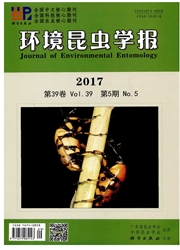

 中文摘要:
中文摘要:
为了了解蚜虫蜜露中微生物的种类组成、多样性水平及其季节变化动态,本研究采用传统的微生物分离培养与16S rRNA基因序列相结合的方法进行了柏大蚜Cinara tujafilina (del Guercio)不同季节蜜露样品中可培养细菌的研究。研究结果表明:(1)蜜露中可培养细菌的数量和多样性变化动态与蜜露采集季节密切相关:总体上看,2011年夏秋两季蜜露中细菌数量产生较大的波动,在7月达到最大值,多样性指数为7月〉 10月〉 8月〉 9月;2012年春季蜜露中细菌数量波动较小,整体处于较低水平,6月最低,但多样性指数为6月〉 5月〉 4月。(2)从所有7个月的的蜜露样品中共分离到25个属的细菌,其中芽孢杆菌属Bacillus、短小杆菌属Curtobacterium和土壤杆菌属Agrobacterium的细菌在不同月份的蜜露样品中都表现出明显的菌落数量优势。就季节分布而言,芽孢杆菌属Bacillus的细菌在蜜露样品中最常出现,其次为短小杆菌属Curtobacterium、不动杆菌属Acinetobacter、鞘氨醇单胞菌属Sphingomonas和链霉菌属Streptomyces。(3)系统发育分析显示,在所有分离到的菌株中,71.2%的菌株属于变形菌门Proteobacteria,为优势菌群;其他27.4%和23.3%的菌株分别属于厚壁菌门Firmicutes和放线菌门Actinobacteria,仅有1个菌株属于拟杆菌门Bacteroidetes。本研究发现柏大蚜蜜露中存在丰富的细菌种类,我们将进一步深入研究不同蚜虫蜜露中微生物的组成,探讨相关细菌在植物-蚜虫-天敌之间可能发挥的作用。
 英文摘要:
英文摘要:
In order to reveal the bacterial composition and their seasonal dynamics, we investigated the culturable bacteria in honeydew of Cinara tujafilina (del Guercio) collected from different months with culture-dependent method combined with 16S rRNA gene sequence analysis. The results showed: (1) the quantity and diversity dynamics of culturable bacteria in honeydew was closely related to sampling season. Overall, the bacterial quantity in summer and fall of 2011 showed great fluctuation, which reached maximum in July. The bacterial diversity index of July sample also reached maximum in this year, followed by samples of October, August and September. The bacterial quantity in spring of 2012 was relatively steady, which reached minimum in June. The bacterial diversity index of June sample reached maximum in this year, followed by samples of May and April. (2) Isolated bacterial strains from seven honeydew samples belong to 25 genera, and this showed that the honeydew of C. tujafilina harbored abundant bacteria, among which, Bacillus, Curtobacterium and Agrobacterium showed obvious superiority in colony quantity. As for seasonal distribution of bacteria, Bacillus occurred most frequently in honeydew, followed by Curtobacterium, Acinetobacter, Sphingomonas and Streptomyces. (3) Phylogenetic analysis showed that 71.2% strains were Proteobacteria, 27.4% and 23.3% strains were Firmicutes and Actinobacteria respectively, and only one strain belonged to Bacteroidetes. Although we cannot detect the symbiota in the honeydew, but we found that many other bacteria species exist in the honeydew of C. tujafilina. We will further compare the bacterial communities in the honeydew of different aphids, and discuss their possible roles playing in the reciprocal symbiosis between aphid-host tree-natural enemies.
 同期刊论文项目
同期刊论文项目
 同项目期刊论文
同项目期刊论文
 期刊信息
期刊信息
